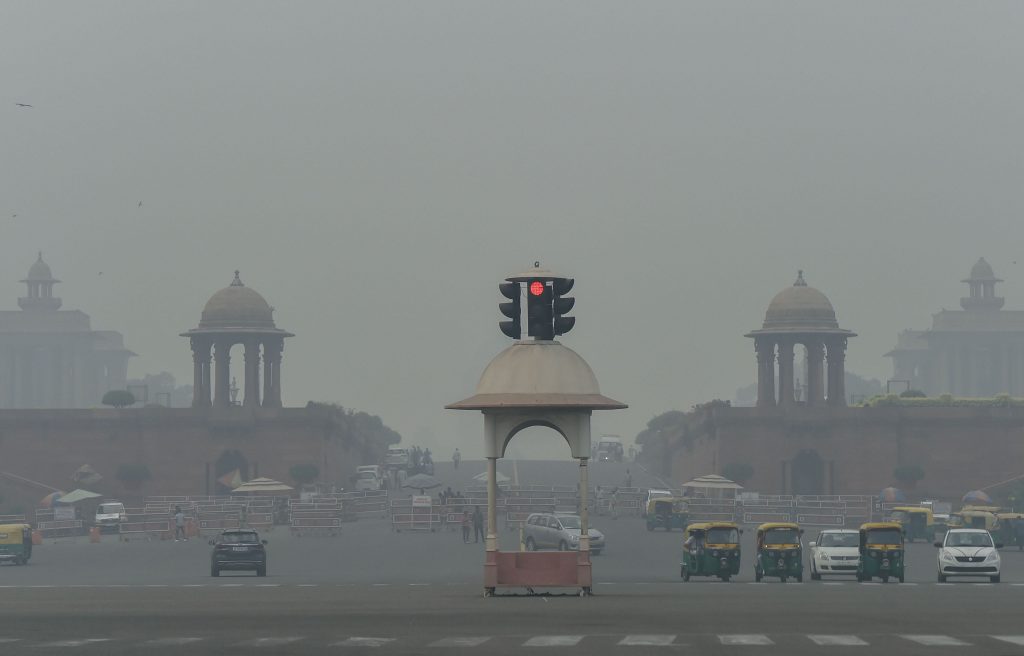
The governments of Delhi, Haryana and UP, despite their best efforts, failed terribly to stop air from getting severely toxic by an hour. The NCR region comprising Delhi, Gurugram, Faridabad, Noida and Ghaziabad clocked an average AQI of over 400 at a stretch for a week, writes Aayush Goel
It’s that time of year again when haze grips everything in Delhi NCR be it air, news or politics. As the air quality dips, the cosmopolitan region of the country starts coming to stand still with smog weighing down the fast pace of life.
While it’s an annual affair now, the region is seeing the worst air quality in a decade forcing the Commission for Air Quality Management to impose strictest anti-pollution measures or stage 4 of Graded Response Action Plan (GRAP). The health authorities have declared an emergency with unprecedented increase in pulmonary and ophthalmic distress cases with infants and cardiac patients being the worst hit.
Amidst blame game, the governments of Delhi, Haryana and UP have done all in their might but failed terribly to stop air from getting severely toxic by an hour. What came as respite was overnight showers just before Diwali which did improve quality but it continued to be in a very poor or poor category in the majority of the regions. AQI in the range of 401-500 is categorised as ‘severe’, while 301-400 is very poor, and 201-300 is poor. The NCR region comprising Delhi, Gurugram, Faridabad, Noida and Ghaziabad clocked an average AQI of over 400 at a stretch for a week.
In the case of Delhi, there have been numerous studies, reports, papers, seminars, monographs, speeches, and explanations on the subject. A recent study has identified Delhi as the most polluted city in the world, with residents potentially losing a significant portion of their lifespan due to pollution. The study, called the Air Quality Life Index (AQLI), was published in August 2023 by the Energy Policy Institute at the University of Chicago. It also indicated that the entire Indian population of 1.3 billion people lives in areas with an annual average particulate pollution level exceeding the WHO’s limit of 5 μg/m3. While Centre for Science and Environment (CSE) holds vehicular emissions, construction dust and smoke from farm fires three major contributory factors to Air-poclypse, but the major part of the blame for the mess has been apportioned to stubble burning in Punjab. Delhi wasn’t always like this in November. It wasn’t so about a decade back. Punjab existed, and so did its farms. So what changed?
Punjab farm fires and pollution in Delhi
Like all previous years, the stubble burning in Punjab is being held as a key culprit for the crises. The state has so far reported 25,000 cases of farm fires this season with highest single day cases rising to over 2000. Just like the previous government, even the current AAP government has failed to curtail the menace. A recent video from Bhatinda showed farmers holding a government officer hostage who came to stop them from torching stubble and forcing him to do so. The video led to huge uproar and Bhagwant Mann-led
The AAP government was accused of inaction. The state had registered only 18 FIRs till November 6 and none was from CM’s constituency, Sangrur, which reports the highest number of fires every day. Following the SC rap, the FIRs rose to 51 and Rs 1.3 crore was released in fines. The Bench said, “You will register FIRs, but they will be withdrawn. This is again a political issue”.
It may be noted that Delhi environment minister Gopal Rai blames UP and Haryana stubble burning for Delhi air crises though opposition is up against the same. “Arvind Kejriwal blames Punjab every year for Delhi crises. This time, when Delhi is facing its worst crisis, he has nothing to say as it is the AAP government in Punjab that has failed terribly. They are making excuses, harassing residents in Delhi but not ready to ask the Mann government to act,” said Punjab BJP President Sunil Jakhar.
Punjab AAP chief spokesperson Malvinder Singh Kang said that stubble burning for the majority in Punjab was not a choice but compulsion and thus penalisation was the last resort. “Stubble burning incidents were reduced by 30 percent last year; it has further declined by 40 percent this year. Farmers have to do so due to lack of alternatives. Penalisation should be the last resort. We have already started taking steps and have banned the PUSA-44 variety of paddy and getting special incentives for crop diversification,” says Kang while talking to Tehelka.
The Supreme Court bench led by Justice S.K. Kaul asked the Centre and states to find a solution to the problem. “We want farm fires stopped, we want air quality to get better, and we want long-term measures for crop replacement,” it said, adding “If you don’t, we’ll summon the Chief Secretaries and keep them here till they find a solution. I’m sure they’ll work better in their own offices, so please find a solution.”
According to experts these farmers only grow rice and wheat because they are purchased by the government at a minimum support price (MSP). They have very little time between these two crops. The alternative to stubble burning is very expensive for farmers. The shift from manual to combine harvesters to harvest and thresh paddy is a key factor. Though combine harvesters were introduced much earlier, their use went up massively after the year 2000. Experts however hold shift in paddy season as the key reason behind the worsening situation.
Worried about depleting ground water due to paddy cultivation, the Punjab Preservation of Subsoil Water Act was brought in 2009 that made farmers shift paddy-sowing time. Paddy requires a lot of water, especially in the initial weeks. It is estimated that if paddy is sown in April-May, producing a kilogram of rice would require 4,500 litres of water, but if sowing dates are shifted to mid-June, the water requirement comes down to 1,500-2,000 litres. Punjab’s 2009 law barred farmers from paddy sowing in nurseries before May 15 and transplanting before June 15. Before the law was passed, farmers were nursery-sowing paddy in April and transplanting seedlings in May. This delayed harvesting to November and thus farm fires. This coupled with low wind speed and high moisture traps the pollutants in the air.
Is Haryana any better?
“We have asked for water not air pollution or blame for the same by Punjab,” says Haryana Agriculture Minister JP Dalal. During the period from September 15 to November 7, a total of 22,644 cases of stubble burning have been recorded, out of which 20,978 (93%) were in Punjab and 1,605 (7%) in Haryana. Experts say that Haryana grows Basmati rice while Punjab farmers are more into non-Basmati Pusa 44 variety of paddy. Basmati crop needs delicate handling and so harvesting is mostly done manually. The non-Basmati paddy is harvested by combine harvesters in Punjab. Also, the size of farms in Punjab is much bigger compared to those in Haryana and Uttar Pradesh.
Vehicular emissions and construction
According to estimates by central government agency SAFAR, the percentage contribution of farm stubble fire to Delhi’s PM2.5 concentration had crossed 25 per cent on November 2. It was in the range of 10-20 per cent range in the previous week. In previous years, on the worst days, farm fires contributed up to 40 per cent to Delhi’s PM2.5 pollution, according to the CSE. That generally takes place in mid-November. Emissions from vehicles and industry and biomass burning contribute to the tinier PM2.5 pollutants while construction dust is behind the coarser PM10 pollutants.
According to the CSE. This year, the percentage share of PM2.5 in PM10 has crossed 50 per cent, indicating higher impact of combustion sources of pollution rather than just stubble burning .Vehicular emission is a perennial contributor to Delhi’s air pollution and thus as per GRAP mandate BS 3 engine petrol cars and BS 4 diesel cars have been barred from plying in NCR till further orders. According to reports, there are 75 lakh vehicles registered in Delhi and a third of those are cars. Around 20 lakh vehicles registered outside Delhi also add to the capital’s traffic load, and in turn, vehicular emission. The average level of nitrogen dioxide (NO2), emitted by vehicles, is up by 60 per cent compared to the first week of October last year, says CSE.
Similarly Delhi NCR at a given point and time has over 20,000 registered construction projects on, with highest being in Gurugram and Noida. The AQI analysis shows that it’s the construction hotspots which report the worst air quality owing to the lack of implementation of construction norms. Not even 10 percent of these projects have so far registered themselves on dust portals even though construction dust contributes majorly to particulate matter.












